"Wildlife Photographer of the Year" exhibition - "Highly Commended" images
Redazione Art-Vibes | On 07, Set 2024
Il “Wildlife Photographer of the Year” compie 60 anni: in anteprima una selezione di scatti protagonisti dell’esibizione che inaugura a Londra ad Ottobre.
di Redazione Art Vibes
– Picture: © Randy Robbins / Wildlife Photographer of the Year – The Last Resting Place, Highly Commended, Natural Artistry. (Randy Robbins is struck by the unusual beauty of the frosted form of this deer on the forest floor. On an early winter’s morning, Randy was checking the trail cameras near his home when he found the body of this deer. He photographed this poignant moment using his smartphone before the ice could melt.
Location: Near Susanville, California, USA. Technical details: Apple iPhone XR; 4.25mm built-in lens; 1/121 at f1.8).
Un ermellino “danzante”, un ragno psichedelico, un ghiacciaio che si scioglie, sono solo alcune delle straordinarie immagini che partecipano al “Wildlife Photographer of the Year”, concorso sviluppato e prodotto dal Natural History Museum di Londra, giunto ormai alla sua sessantesimo edizione.
La prossima mostra “Wildlife Photographer of the Year” verrà inaugurata a Londra a partire dall’11 ottobre 2024 e presenterà 100 fotografie da tutto il mondo.
Un’edizione che ha attirato un numero record di candidature, ben 59.228, con fotografi di tutte le età e livelli di esperienza provenienti da 117 paesi e territori, che si sono cimentati nella produzione di sensazionali scatti. Le candidature sono state giudicate in forma anonima in base alla loro creatività, originalità ed eccellenza tecnica da una giuria internazionale di esperti del settore.
I vincitori di ogni categoria e i prestigiosi premi “Grand Title” e “Young Grand Title” saranno annunciati l’8 ottobre 2024. Quest’anno è stato altresì introdotto un nuovo premio sia per i concorsi per i giovani che per gli adulti, si tratta dell’Impact Award, un riconoscimento che vuole premiare la migliore storia di speranza legata ad un cambiamento positivo.
In attesa degli scatti premiati, tra le immagini Highly Commended spicca anche un’immagine ripresa con uno smartphone, l’autore è Randy Robbins e protagonista della scena è una femmina di cervo mulo.
Se William Fortescue ha assistito alla complessa relazione dei leoni in accoppiamento, Tommy Trenchard ha invece registrato il momento angosciante in cui uno squalo è stato issato a bordo di un peschereccio spagnolo nell’Oceano Atlantico meridionale.
Ed ancora è di Shreyovi Mehta lo scatto nella categoria “10 anni e meno” che immortala un’’immagine atmosferica di un pavone nel Parco nazionale di Keoladeo a Bharatpur, in India.

©Jose Manuel Grandío / Wildlife Photographer of the Year – Twist and Jump. Highly Commended, Behaviour: Mammals. (Jose Manuel Grandío braves below-zero temperatures to witness a stoat jumping high into the air above the snow. Winter is Jose’s favourite season for photography. When he spotted this stoat jumping mid-air on the last day of his trip, he saw this performance as an ‘expression of exuberance’ as the small mammal hurled itself about in a fresh fall of snow. Scientists refer to this behaviour as dancing, although opinions are divided about what motivates it, from an attempt to confuse prey through to a parasitic infection. Stoats are usually active at night and prey on small mammals and birds. Location: Athose, Bourgogne-Franche-Comté, France. Technical details: Nikon D500 + 500mm f4 lens; 1/6000 at f4; ISO 800).
La presidente della giuria, Kathy Moran, a margine della rassegna ha affermato: “In questa selezione si intravede la diversità delle specie, una gamma di problemi comportamentali e di conservazione. Queste immagini rappresentano l’evoluzione del concorso nel corso degli anni, dalla pura storia naturale alla fotografia che abbraccia pienamente la rappresentazione del mondo naturale, la bellezza e le sfide. È una selezione potente con cui dare il via a un anniversario importante“.
Il dott. Doug Gurr, direttore del museo, ha affermato: “Mentre celebriamo i sessant’anni del Wildlife Photographer of the Year, celebriamo anche le generazioni di visitatori che sono stati ispirati dalla bellezza e dalla maestosità delle sue immagini e dai milioni di collegamenti creati con la natura. Nel corso dei decenni, il Wildlife Photographer of the Year ha ampliato i confini della fotografia naturalistica man mano che la competizione si evolveva parallelamente ai progressi tecnologici.
Ma ancora oggi, la competizione rimane fedele a uno dei suoi obiettivi fondanti: “aumentare il prestigio della fotografia naturalistica nella speranza che alla fine i premi possano giovare agli animali creando un maggiore interesse pubblico nei loro confronti e intorno all’argomento fondamentale: la conservazione“.
La sessantesima edizione del Wildlife Photographer of the Year si terrà al Museum di South Kensington da venerdì 11 ottobre a domenica 29 giugno 2025. La mostra intraprenderà anche un tour nel Regno Unito e a livello internazionale per ispirare milioni di persone ad apprezzare e preservare il mondo naturale.
La sessantesima edizione del Wildlife Photographer of the Year è stata sostenuta dal donatore associato The William Brake Foundation.
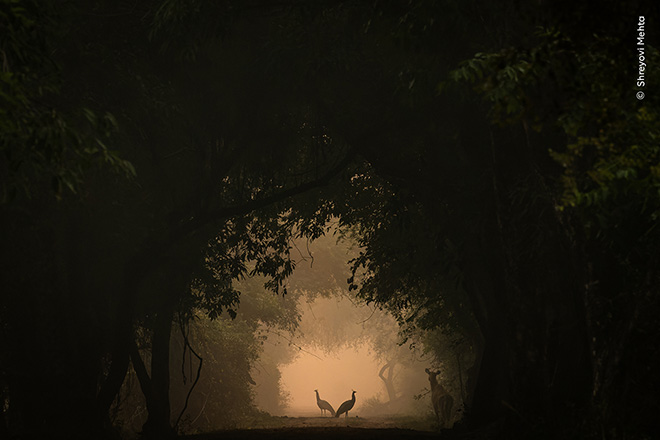
© Shreyovi Mehta / Wildlife Photographer of the Year – In the Spotlight. Runner-Up, 10 Years and Under. (Shreyovi Mehta finds two Indian peafowl ‘looking perfect for a picture’. Shreyovi was walking in the forest with her parents when she spotted this scene. She ran back to her dad, who was carrying the cameras, then got down on the ground to take her photograph from a low angle. Renowned for its birdlife, Keoladeo attracts large numbers of water birds in winter. Peafowl are year-round residents that roost in large trees. They rest in the shade during the day and are more active in open areas at dawn and dusk. Location: Keoladeo National Park, Rajasthan, India . Technical details: Canon EOS R5 + 100–500mm f4.5–7.1 lens; 1/800 at f10; ISO 1600).
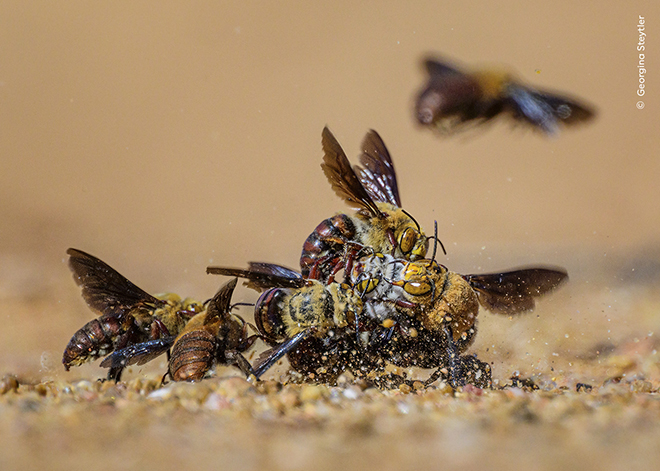
© Georgina Steytler / Wildlife Photographer of the Year – Centre of Attention. Highly Commended, Behaviour: Invertebrates. (Georgina Steytler observes a ball of male Dawson’s burrowing bees vying for access to a female. Georgina has been studying these bees for a few years and knew she had to keep her distance. Lying on the hot, rocky, sun-baked ground with sand blowing in her face, her long lens enabled her to get the perfect image. When female Dawson’s burrowing bees emerge in spring, they are surrounded by males competing to mate with them. After mating, the female bee will dig a new burrow filled with pollen and eggs, from which the hatched bees will emerge in spring. Location: Near Carnarvon, Western Australia, Australia . Technical details: Nikon Z 8 + 800mm f6.3 lens + 1.4x teleconverter; 1/5000 at f11; ISO 640)
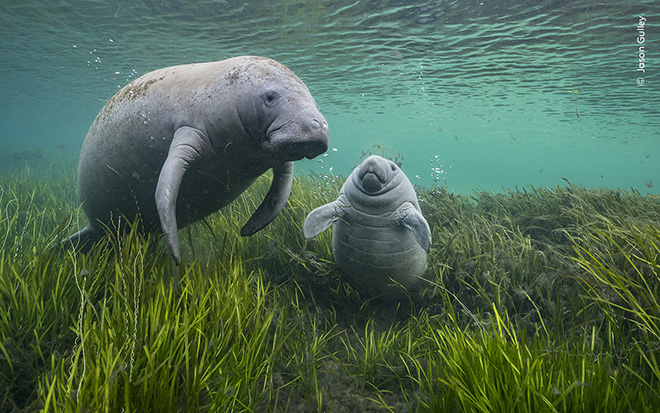
©Jason Gulley / Wildlife Photographer of the Year – As Clear as Crystal, Highly Commended, Underwater. (Jason Gulley gazes through clear water at a manatee and a calf adrift among the eelgrass. Jason has photographed many manatee mother-and-calf pairs. The expression on this calf’s face and the bubbles trailing from its flippers, combined with the hopeful backstory, have made it one of Jason’s favourite images. Here in the Crystal River, an algal bloom caused by agricultural runoff led to a decline in the eelgrass beds that the manatees eat. The local community acted, restoring the habitat and improving water quality, resulting in more manatees than ever being recorded in the winter of 2022/2023. Location: Hunter Springs, Crystal River, Florida, USA. Technical details: Nikon Z 6 + 14–30mm f4 lens; 1/50 at f4; ISO 1000; Nauticam housing + WACP-2 wide-angle conversion port).
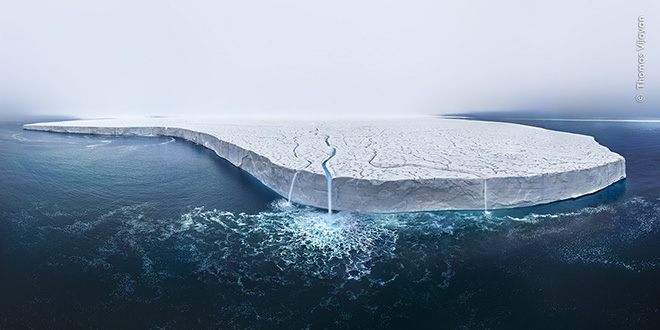
© Thomas Vijayan / Wildlife Photographer of the Year – The Disappearing Ice Cap. Highly Commended, Oceans: The Bigger Picture. (Thomas Vijayan utilises his drone to show the epic scale of the Bråsvellbreen glacier. Encapsulating the magnificence of the Austfonna ice cap required meticulous planning and favourable weather conditions. Thomas’s image, a stitched panorama of 26 individual frames, provides a spectacular summer view of meltwater plunging over the edge of the Bråsvellbreen glacier. The Bråsvellbreen glacier is part of Austfonna, Europe’s third largest ice cap. This dome of ice is one of several that covers the land area of the Svalbard archipelago. Some scientific models suggest that Svalbard’s glaciers could disappear completely within 400 years due to climate change. Location: Svalbard, Norway.
Technical details: DJI Mavic Mini 2 + 24mm f2.8 lens; 26 individual exposures).
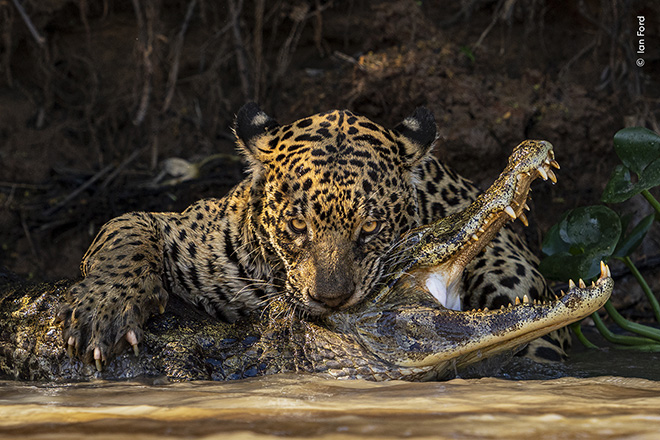
© Ian Ford / Wildlife Photographer of the Year – Deadly Bite, Highly Commended, Behaviour: Mammals. (Ian Ford documents the moment a jaguar delivers a fatal bite to a caiman in the Pantanal. A call over the radio alerted Ian that a jaguar had been spotted prowling the banks of a São Lourenço River tributary. Kneeling in the boat, he was perfectly placed when the cat delivered the skull-crushing bite to the unsuspecting yacare caiman. The South American Pantanal wetland supports the highest density of jaguars anywhere in the world. With prey being so abundant, there is no need to compete for food, and the usually solitary big cats have been seen fishing, travelling and playing together. Location: Pantanal, Mato Grosso, Brazil. Technical details: Sony α1 + 400mm f2.8 lens; 1/800 at f4 (-1 e/v); ISO 400)
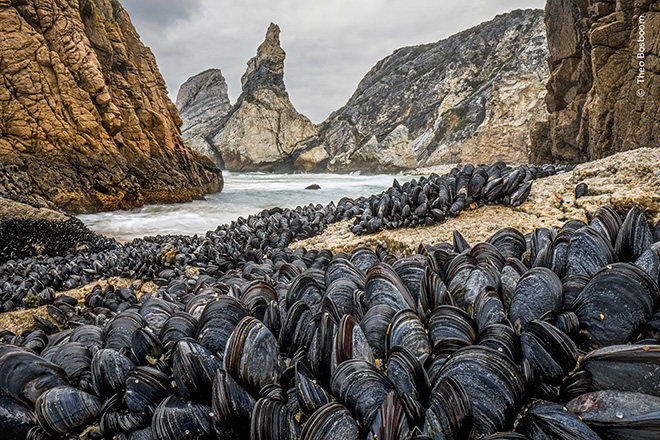
© Theo Bosboom / Wildlife Photographer of the Year – Strength in Numbers, Highly Commended, Animals in their Environment. (Theo Bosboom shows how mussels bind together to avoid being washed away from the shoreline. Theo likes to take images of species that aren’t usually considered beautiful or important, to highlight their unappreciated significance. He took this image from above with a probe lens – a long, thin, macro wide-angle lens. Mussels play an important role in creating dynamic ecosystems for other marine invertebrates such as crustaceans, worms and even small fish. They improve the water quality by filter-feeding, extracting plankton as well as bacteria and toxins, which prevents them from building up to dangerous levels. Location: Praia da Ursa, Sintra, Portugal. Technical details: Canon EOS R5 + Laowa 24mm Periprobe lens; 0.6 sec at f32; ISO 200; focus stack of 9 images).
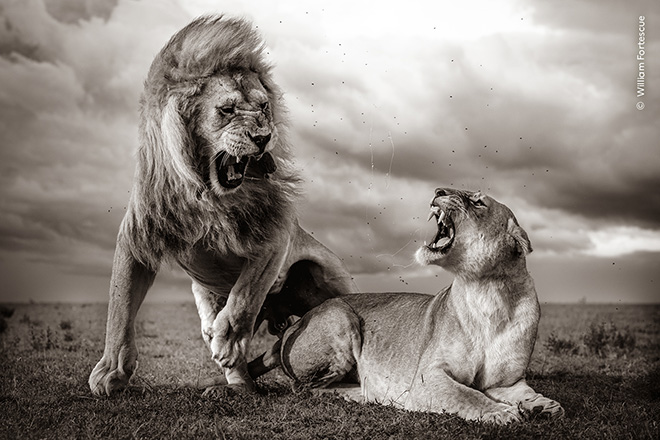
© William Fortescue / Wildlife Photographer of the Year – Stormy Scene, Highly Commended, Behaviour: Mammals. (William Fortescue uses a backdrop of storm clouds lit by the setting sun to show mating lions.
It was the rainy season when William visited the Serengeti National Park. He watched the lions mate several times before the female broke it off. It wasn’t until William viewed an enlarged image that he noticed the saliva trails and the explosion of insects from the male’s mane. Lions can mate throughout the year, but synchronising the births of cubs increases the reproductive success of a pride. Female pride members display cooperative behaviours, including raising cubs together to ensure their survival into adulthood. Location: Namiri Plains, Serengeti National Park, Tanzania. Technical details: Nikon Z 9 + 70–200mm f2.8 lens; 1/1000 at f5; ISO 320).
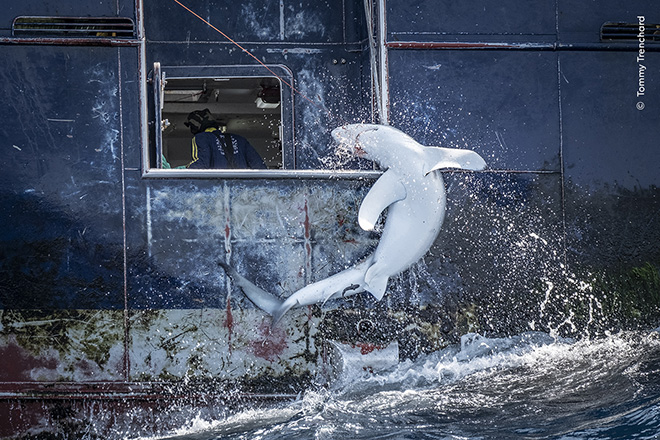
© Tommy Trenchard / Wildlife Photographer of the Year – Hooked, Highly Commended, Oceans: The Bigger Picture. (Tommy Trenchard documents the bycatch of a requiem shark, its body arched in a final act of resistance. Tommy was travelling on the Greenpeace ship Arctic Sunrise. The ship’s research expedition aimed to document the bycatch or accidental capture of sharks by fishing boats targeting tuna and swordfish, and to highlight the lack of effective regulation of industrial-scale fishing in international waters. Approximately 80 million sharks are taken from the world’s oceans every year. Because of fishing, numbers of sharks worldwide have dropped since 1970. Three quarters of all shark species are now at risk of extinction. Location: International waters, South Atlantic Ocean. Technical details: Fujifilm X-T2 + 50–230mm f4.5–6.7 lens; 1/550 at f5.2; ISO 500).
– via: nhm.ac.uk/events/wildlife-photographer-of-the-year-tour
– Exhibition info: “Wildlife Photographer of the Year”
– When: 11 ottobre 2024 – 29 giugno 2025.
– Where: Natural History Museum, London.

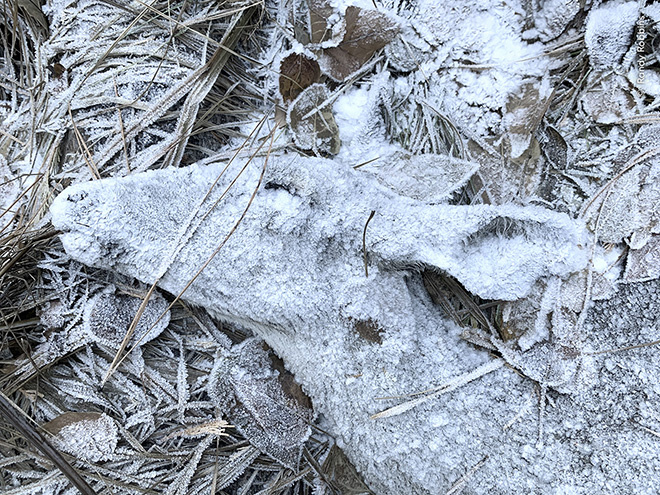
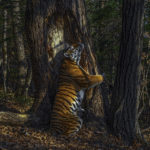
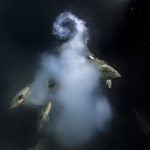
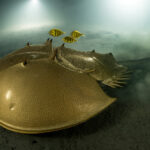
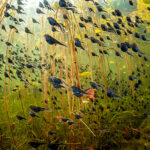



























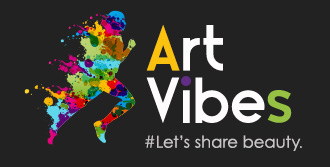

Submit a Comment